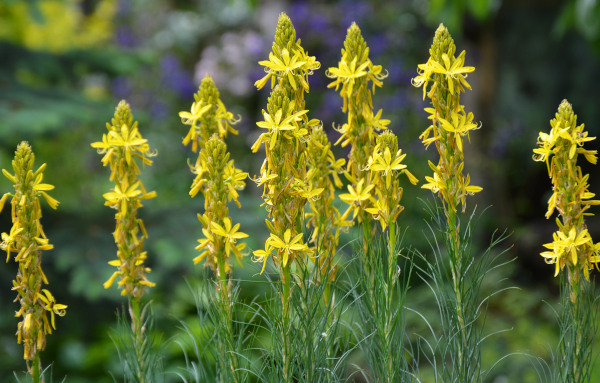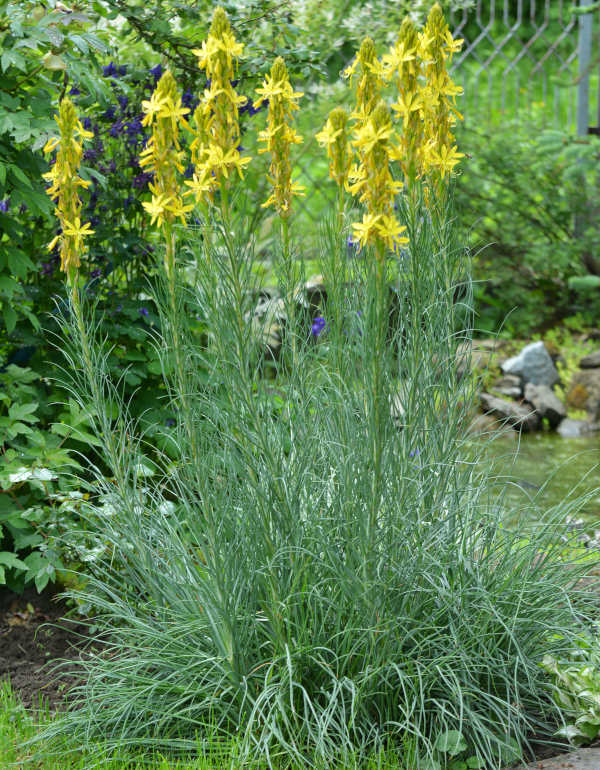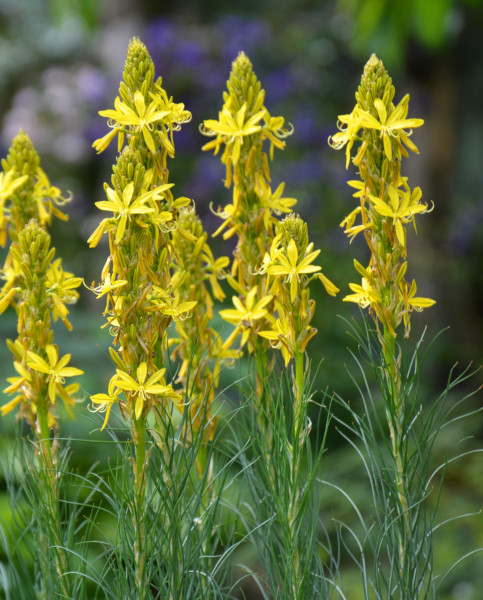How to grow Asphodeline
Also known as King’s spear or Jacob’s rod, asphodeline is a distinctive perennial with tall, elegant spikes of starry flowers which can be yellow or white depending on the species or cultivar. It is generally associated with the Mediterranean, where it grows wild in sunny, rocky meadows and on dry slopes.
The two most widely cultivated species are Asphodeline lutea which flowers in late spring, and Asphodeline liburnica which tends to bloom a little later in midsummer. Both are clump-forming perennials which grow from clusters of fleshy rhizomes and produce grass-like, blue-green leaves.

Key Information
Soil pH
Position
Hardiness


Where to plant Asphodeline
For best results, plant in autumn or spring. An autumn planting can be done by those gardening in mild conditions (and broadly speaking, this is the southern half of the UK). For those liable to cold winters, it is best to wait until spring (generally the northern half of the UK). Planting can also be carried out in summer, though be prepared to water regularly.
Asphodeline is perfect for a sunny, well-draining border, or a dry, sunny bank. It also makes a good choice for a gravel or mediterranean garden, or a coastal environment. For the greatest visual impact grow in a generous drift, or alternatively weave throughout a scheme for striking vertical accents.
Asphodeline can also be grown in a container.
How to plant Asphodeline
- For planting in the garden, dig the soil area removing any large stones and weeds and breaking up any lumps. If your soil is poor mix in some organic matter such as manure or garden compost. If it is more on the moist side, add a generous amount of horticultural grit. Rake level and firm with your heels. Rake level again.
- Water plants well and allow to drain before planting.
- A good tip is to dig a hole twice the size of the root-ball. Fill with water and allow to drain before placing in the plant.
- Place the plant in the hole, ensuring the top of the root ball sits level with the surface of the soil. Too low and the plant may rot, too high and the roots can dry out.
- Backfill with soil and firm in gently with your foot.
- Soak well with water.
- Mulch around the base with well-rotted organic matter.
- For planting in containers, first choose an appropriately sized pot. The best practice is to start just a few centimetres larger than the rootball and increase in size every year or two. Always ensure there are plenty of drainage holes in the bottom.
- If you are using a large or heavy pot, it can be a good idea to fill and plant it in situ to save yourself the trouble of moving once full.
- Use a good quality potting compost with plenty of horticultural grit mixed in, and, if not already present in the compost (check the description on the bag) some slow-release fertiliser granules.
- Start by partially filling the pot with compost; enough so that when placed on it the upper surface of the root ball is about 3cm lower than the top of the pot.
- Infill all the space surrounding the root ball with compost, firming down with your fingers then adding a little more so the plant is held tight.
- Pick up the container and lightly tap on the potting bench or ground a few times to help further settle the compost around the plant.
- Soak well with water.
- A mulch with horticultural grit will look attractive and help to prevent a ‘cap’ or crust forming on the top of the compost (something container plants can suffer due to the artificial nature of their watering).

How to care for Asphodeline
Pruning and Deadheading
Flower spikes can either be cut back after blooming or left over winter for their attractive seedheads.
Watering
During the first year in the ground, water your asphodeline regularly until established (i.e., the first few weeks), and then only in very hot dry spells after this. From year two onwards, asphodeline is known to be drought tolerant so shouldn’t require any attention in this respect.
Container-grown asphodeline has less access to moisture and will need watering throughout every growing season. Aim to water deeply and thoroughly, then allow the compost to almost dry out completely before repeating. This is to avoid having the roots sitting too wet, something these drainage-loving plants dislike.
Feeding
On healthy, fertile soil, a mulch of well-rotted organic matter (i.e., a layer of manure or garden compost applied to the soil around the plant) should provide enough nutrients for your asphodeline. This has the added benefit of suppressing weeds and locking in moisture. Mulch when planting, and then again every spring.
If you garden on very poor soil or feel your asphodeline could do with a boost, applying a general-purpose granular feed to the surface of the soil and lightly working in (known as a ‘top dress’) can reap benefits. Do this when mulching – first apply the top dress, then cover with the mulch.
Container-grown asphodeline is different, relying solely on the gardener for nutrition. Get off to a flying start by making sure you use a good quality compost with some slow release fertiliser granules mixed in. After this, carry out a replenishing ‘top dress’ annually in spring. This means simply scraping away the top few centimetres of compost and replacing with a fresh load with fertiliser granules mixed in. Remember also to repot your asphodeline every few years.
Cold Protection
Asphodeline has a hardiness rating of H4, which means it should withstand an average UK winter without the need for additional protection. It may struggle in a very cold, wet winter, so if you live in the north it can be worth protecting each plant with a dry, insulating mulch piled over the crown of the plant in autumn. This might be straw, bracken, bark chippings, or similar.
Any H4 plant in a container will benefit from having its roots wrapped in fleece, hessian, or bubblewrap in all but the mildest or most protected spots. This also reduces the likelihood of the container cracking during frosts.
Pests and Diseases
Asphodeline is considered problem-free.
How to propagate Asphodeline
The quickest and easiest way to propagate asphodeline is by lifting and dividing established clumps in late summer or early autumn. As well as providing new plants this has the added benefit of reinvigorating existing clumps. Allow 2-3 years between each division so the plant can sufficiently re-establish.
- Dig the plant out of the ground, taking care not to damage the brittle, fleshy rhizomes.
- Shake off any excess soil.
- Gently tease the fleshy rhizomes apart by hand, aiming to retain two to three growing points on each new clump.
- Replant decent-sized pieces where desired, and any smaller bits can be potted up.
- Give a good soaking, and continue to water in any hot, dry weather as per our ‘Watering’ section above.
Another method, which can be done with greater frequency than division, is to collect and sow seed.
- Seeds are typically ready for collecting in late summer when the seedheads have dried and turned brown.
- Snip the seedheads from the plant using scissors or secateurs. Try to do this in dry conditions, and place in a small, labelled paper bag or envelope. Store somewhere cool and dry until the following spring.
- In late spring, fill a seed tray or small pot with a very well-draining compost mix, compressing the surface lightly with a flat piece of wood or the bottom of another pot.
- Sprinkle the seeds evenly over the surface of the compost.
- Use a garden sieve to cover with a fine layer of compost.
- Water the soil gently with a fine spray until it is evenly moist but not waterlogged.
- Place the seed tray or pots outside, into a bright, semi-protected environment such as an open cold frame or in the shelter found in front of a wall.
- When the seedlings have grown large enough to handle, transplant them into individual 9cm pots filled with a well-draining mix.
- Move to a frost-free environment such as a cool greenhouse, conservatory, or porch for winter, keeping barely moist, never soggy.
- Plant out the following late spring to early summer, following our ‘How to plant asphodeline’ section above.
* Many plants carry Plant Breeders Rights and cannot be propagated for commercial purposes.
Common Asphodeline questions
- What does asphodeline smell like?
Some species have no fragrance, while others emit a light, sweet scent. Check individual descriptions for details. - Is asphodel a type of lily?
Asphodeline was formerly included in the lily family (liliaceae), before being assigned its own family – asphodelaceae.
- Can you grow asphodeline indoors?
Asphodelina is a fast-growing, sun-loving plant which is best suited to the conditions found outdoors. An indoor environment is unlikely to offer enough light, which will probably mean weak growth and an increased susceptibility to pests and diseases.




